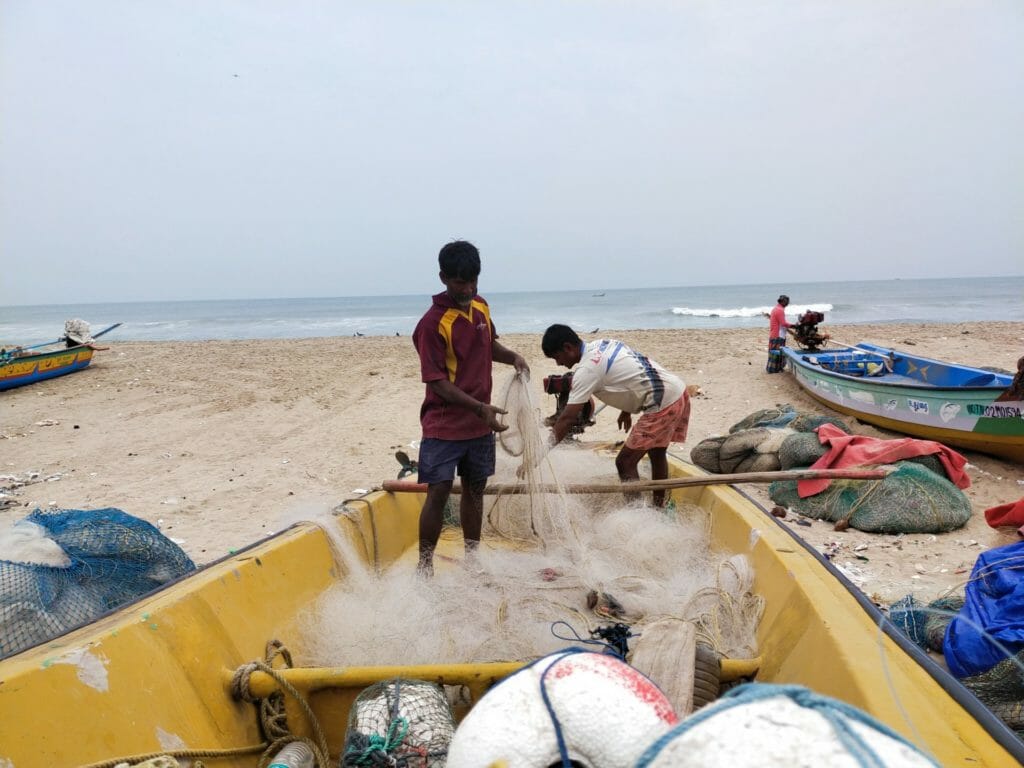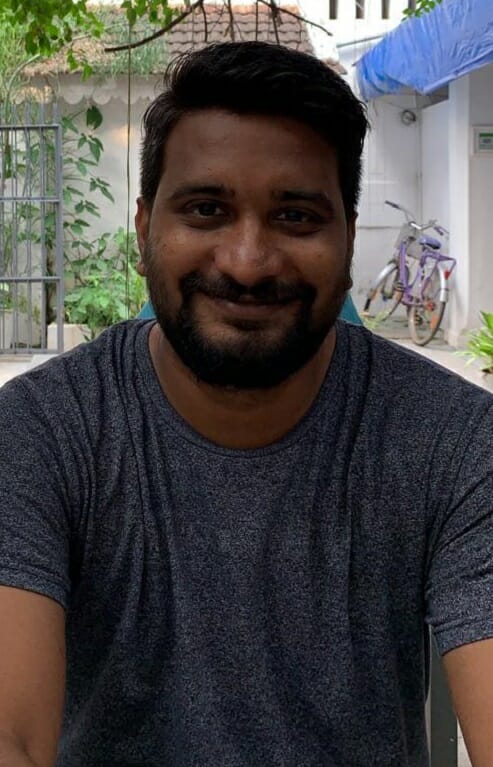“Plastic found in the stomach of fish” read a recent, alarming headline.
The increasing instance of such findings shows how the issue of marine litter poses a growing threat to marine biodiversity and the health of human beings, as marine litter in its various forms makes its way into the food chain.
A study conducted by the Tamil Nadu government found that people living around 19 estuaries in the state, including those around Ennore Creek, Cooum and Adyar estuary, could be ingesting microplastics by including fish in their diet. A total of 23 polymers were identified across all the estuaries. Of this, polyethylene and polypropylene, which are used to make fishing nets, bottles and bags, were found to be predominant.
How is a decision to buy a product in a plastic bag going to affect the marine ecosystem, livelihood of the fisherfolk, and quality of the fish on our plates?
To understand these connections, Citizen Matters Chennai had a conversation with Rahul Muralidharan, a political ecologist based in Tamil Nadu, researching coastal and marine governance and transformations.
Rahul has a Master’s degree in Marine Studies and Coastal Resource Management from Madras Christian College, Chennai and a PhD in Conservation Science and Sustainability Studies from Ashoka Trust for Research in Ecology and the Environment (ATREE), Bangalore.
He has over a decade of experience working with artisanal and small-scale fishing communities and on marine ecological issues along the Tamil Nadu coast, bringing together interdisciplinary approaches to address issues over environmental justice and social equity.
His doctoral work explores the political ecology of marine conservation along Tamil Nadu.
Here are some excerpts from the interview:
Causes and impact of marine litter in Chennai
What is marine litter? How does it enter the marine ecosystem?
According to the United Nations Environment Programme (UNEP), marine litter is any persistent, manufactured or processed solid material discarded, disposed of or abandoned in the marine and coastal environment. It consists of items made or used by people and deliberately discarded into the sea or rivers or on beaches; brought indirectly to the ocean with rivers, sewage, stormwater or winds; or accidentally lost, including material lost at sea in bad weather.
Marine litter originates from many sources and causes a broad spectrum of environmental, economic, safety, health and cultural impact.
The very slow rate of degradation of most marine litter items, mainly plastics, together with the continuously growing quantity of litter and debris disposed of, is leading to a gradual increase in marine litter found at sea and on the shores.
Why should this be a matter of concern for the average Chennai resident who goes to the beach for entertainment over the weekend?
Everybody should be concerned about an environmental crisis. In popular discourse, most of the recent news reports suggest that those who have makeshift shops near the ocean are the ones who pollute the beach. This is an example of apportioning blame to a group of people for an issue that all of us have equal responsibility for.
Even the measures taken by the government for ‘clean beach’ campaigns are very cosmetic in nature.
How has marine litter affected the livelihood of Chennai fisherfolk?
Those who are most affected by marine litter in Chennai are the small-scale/artisanal fishers who fish close to the shore. The estuaries and the rivers that are emptying into the sea in addition to the solid waste dumped closer to the shore are the source of plastic waste.
The deep sea fishers or the trawlers also pick up plastic waste from their catch but the ones that are specifically affected are the artisanal fishers.

For instance, Adyar flows from Chembarambakkam to the Bay of Bengal for a stretch of around 40 km. Along the way, the river picks up the trash which includes the medical waste that is dumped into the tanks.
Adyar River is a very important ecosystem not only for the marine fishers but also for the inland fishers. Estuaries, on which these inland fishers highly depend, are highly productive ecosystems which is basically the nursing ground for fish. The inland fishers and those fishers from Urur Olcott Kuppam depended on the river for their livelihood in the past. These fishers have entirely lost their livelihood because of the indiscriminate practice of dumping solid waste, particularly plastics, into water bodies.
Plastics not only smother the ecosystem but also entangles in fishing nets which causes a problem for the fishers. The area of the net through which the fish enters gets blocked by the plastics.
It also increases the labour of the fishers. Small-scale fishing is a labour-intensive activity. Nets are cast manually and retreated. For instance, a fisherman who uses a cast net will have to retreat it to take the fish out and put it back into the water. When the marine litter gets entangled in the net, it becomes a highly time-consuming activity to remove the litter before putting the net into the water. Some of these fishing methods are very time specific which is done when the tide comes in. They have a very small window (usually an hour or two) as well. If they cannot cast the net and finish fishing for the day in the given time period, they face a loss.
Some of my interactions with the fishers also indicate that marine litter, mostly plastics, accumulate at the point where the waves break in the ocean.
The near-shore ecosystem is the highly productive ecosystem where fish reproduce and lay their eggs and most of them are found on the sea beds. This area also provides warmth for the eggs to incubate.
When these ecosystems are affected by marine litter that includes plastics, not only does it affect the ecosystem but also the direct income of the fishers in Chennai. Though there are no concrete studies to prove these connections, most of the anecdotal experiences stand witness to it.
Read more: Let’s go to Spring Potato beach; sorry, we mean Besant Nagar beach
The government has undertaken many projects along the coastal line in Chennai including efforts towards the construction of a Pen Monument in the sea. How will this contribute to marine litter?
This is going to have a clear impact on the marine ecosystem and the livelihood of the fisherfolk. Any sort of structure in the sea is going to change the sand dynamics. The area earmarked for the construction of the Pen Monument is a highly productive fishing ground. Fishing villages along this line have relied upon these resources for several generations. The different kinds of fishing activities here reflect the diversity of the fish species.
It is absolutely foolish to construct something in a sea, especially when we are facing the impacts of climate change. Rather than descaling the infrastructure along the shore, the government has been intensifying such activities.
Solutions to tackle marine litter in Chennai
Several studies have shown that single-use plastic is the major contributor to marine litter. What would you suggest as a solution for this?
Fossil fuel is the culprit. Plastic is the byproduct of the petroleum production process. Other than banning single-use plastic there is no other go. However, we are so used to single-use plastic that it has become very challenging to remove it from circulation.
Since single-use plastic is very cheap, it is the only mode of packaging that is used by many small shops. If stopping the manufacturing of single-use plastic requires time, the state should come up with alternative packaging materials and provide them at a subsidised rate for the marginalised vendors.
Greater Chennai Corporation has been taking several measures to deal with plastics, including door-to-door collection of household waste. How efficiently do you think that has worked so far?
When Urbaser Sumeet took over the solid waste management contract in Chennai initially, I found them working well. They used to do proper door-to-door collections and announcements on source-level segregation. Over time, I see that they have not been doing so much at least on a scale that they used to do before. The biodegradable and non-biodegradable waste is mixed at the source.
While the state is taking steps to reduce the quantity of waste that ends up in landfills, we should also acknowledge that there is a lack of cooperation from the public on source-level segregation of household waste.
What has the government been doing to address the issue? What are your thoughts on the formulation of a National Marine Litter Policy (NMLP)?
From my observation, the way the government has been maintaining the area of the Adyar River near the Broken Bridge and the area around Eliot’s beach needs improvement. People who come to Elitot’s beach should be able to take a walk to the side of the Adyar River to see the amount of trash that ends up there which eventually becomes marine litter.
While this might help in creating some kind of awareness, the public at large should also be aware of the consumption side of the issue. They should think of using alternatives to plastics and also encourage and incentivise those shopkeepers who provide such alternatives.
The Tamil Nadu government has launched the ‘Meendum Manjappai’ campaign to promote the use of cloth bags as an alternative to plastics. It is a welcome initiative.
However, any sort of government initiative or scheme should also include the monitoring and impact assessment components. Without that, we cannot understand its impact.
From a more critical point of view, I find some such initiatives to be greenwashing as the source of the problem is not addressed.
While we need a national policy to address marine litter, I also find that we need a state-level policy in place. A decentralised policy is needed to understand the trends in consumption that directly impact the environment.
Of course, we need an umbrella policy at the national level but we also need to scale it down to particular geography to create tailor-made solutions for a particular geography.
Read more: Chennai’s Pen Monument could adversely impact environment and livelihood
What do you think citizens can do on their part to reduce their contribution to marine litter?
Consumption is the root cause of marine litter in Chennai and elsewhere. It includes what we buy, what we throw and where the waste we throw ends up. The issues start with consumption rather than responsible disposal of trash. Though we can keep a number of garbage bins near the beach to collect the trash, many people do not think about it once the trash is out of sight.
A cultural transformation seems to be the need of the hour in terms of consumption.
What citizens can do
- Being aware of what we are consuming and reducing conspicuous consumption
- Adopting reusable packaging
- Switching to shopping from local grocery stores that use sustainable packaging
- Finding sustainable alternatives to plastic packaging wherever possible
- Working to hold manufacturers accountable to create more sustainable packaging
We need more research to understand how land-based pollutants like plastic enter the sea and what happens there. This is needed to understand the magnitude of the impact plastics have on the marine ecosystem and this might change the people’s attitude towards the consumption at large.
